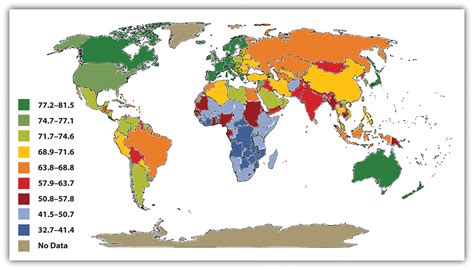Introduction

Life expectancy, a key indicator of a population’s health and well-being, serves as a vital lens through which we can explore the intricate tapestry of human geography. By examining life expectancy patterns, we gain insights into the socio-economic, environmental, and cultural factors that shape our lives and societies.
Determinants of Life Expectancy
Life expectancy is influenced by a myriad of factors, including:
Socio-economic Factors:
- Income: Wealthier individuals tend to have better access to healthcare, education, and nutrition, all of which contribute to increased life expectancy.
- Education: Education empowers individuals with knowledge and skills to make informed decisions about their health and well-being.
- Occupation: Certain occupations, such as those involving hazardous activities, can shorten life expectancy.
- Social support: Strong social networks provide individuals with emotional and practical support, reducing stress and improving overall health.
Environmental Factors:
- Air quality: Exposure to air pollution, particularly in urban areas, can lead to respiratory and cardiovascular diseases, reducing life expectancy.
- Water quality: Access to clean water is essential for human health and survival. Contaminated water can cause waterborne illnesses, decreasing life expectancy.
- Urbanization: Densely populated urban environments often exacerbate health issues related to air pollution, stress, and lack of green space.
Cultural Factors:
- Nutrition: Cultural practices and dietary preferences influence nutritional intake, which can have profound effects on health and life expectancy.
- Smoking: Tobacco use is a major risk factor for a wide range of health problems, including lung cancer and heart disease, significantly reducing life expectancy.
- Alcohol consumption: Excessive alcohol consumption can damage the liver, heart, and other organs, shortening life expectancy.
Regional Patterns of Life Expectancy
Life expectancy varies widely across the globe, with significant regional differences:
- Developed Countries: In highly developed countries such as Japan and Switzerland, life expectancy exceeds 80 years due to advanced healthcare, high levels of education, and healthy lifestyles.
- Developing Countries: In many developing countries, life expectancy is lower than 60 years due to poverty, limited access to healthcare, and environmental hazards.
- Regional Disparities: Even within developed or developing countries, there can be substantial disparities in life expectancy based on factors such as socioeconomic status and geographic location.
Tables
Table 1: Comparison of Life Expectancy by Socio-economic Factors
| Factor | Life Expectancy (years) | Additional Notes |
|---|---|---|
| High Income | 80+ | Access to high-quality healthcare, education, and healthy diets |
| Middle Income | 65-80 | Varying levels of healthcare, education, and environmental conditions |
| Low Income | Less than 65 | Limited healthcare, education, and exposure to environmental hazards |
Table 2: Environmental Factors Affecting Life Expectancy
| Factor | Effect on Life Expectancy | Examples |
|---|---|---|
| Air Pollution | Reduced respiratory and cardiovascular function | Urban smoggy environments |
| Water Contamination | Waterborne diseases and health issues | Contaminated drinking water sources |
| Climate Change | Heat-related illnesses, increased disease transmission | Rising temperatures, extreme weather events |
Table 3: Cultural Influences on Life Expectancy
| Factor | Effect on Life Expectancy | Examples |
|---|---|---|
| Healthy Diet | Increased longevity | Mediterranean diet, Japanese cuisine |
| Smoking | Decreased life expectancy | Lung cancer, heart disease |
| Alcohol Consumption | Shortened life span | Liver damage, cardiovascular issues |
Table 4: Global Life Expectancy Trends
| Region | Life Expectancy (years) | Change from 2000 |
|---|---|---|
| Developed Countries | 80+ | +2 years |
| Developing Countries | 65-80 | +5 years |
| Least Developed Countries | Less than 60 | +3 years |
Implications for Human Geography
Life expectancy data provides valuable insights for human geographers:
- Population Growth and Structure: Declining life expectancy can lead to population decline, while increasing life expectancy can contribute to population growth.
- Health Disparities: Life expectancy differences highlight social and economic inequalities that can inform health policies.
- Urban Planning: Understanding life expectancy patterns can guide urban planning decisions, such as the provision of green spaces and healthcare facilities.
- Environmental Sustainability: Life expectancy data can be used to assess the impact of environmental factors on human health and to develop sustainable practices.
Conclusion
Life expectancy is a complex and multifaceted indicator of human well-being. By examining the factors that influence life expectancy, we gain a deeper understanding of the social, economic, environmental, and cultural forces that shape our societies. As human geographers, we can leverage this knowledge to address health disparities, promote healthy environments, and create more equitable and sustainable communities.
Common Mistakes to Avoid
- Overgeneralizing: Avoid assuming that all regions or groups within a country have the same life expectancy.
- Ignoring Socio-economic Factors: Consider the role of socio-economic factors when analyzing life expectancy patterns.
- Missing Environmental Impacts: Don’t overlook the significant influence of environmental factors on life expectancy.
- Failing to Consider Cultural Practices: Understand how cultural practices can influence health behaviors and life expectancy outcomes.
FAQs
- What is the global average life expectancy? Around 73 years.
- Which countries have the highest life expectancies? Japan and Switzerland, with over 84 years.
- Which factors contribute most to increased life expectancy? Access to healthcare, education, healthy diets, and clean environments.
- How can we improve life expectancy? By addressing socio-economic inequalities, reducing environmental pollution, and promoting healthy lifestyles.
- What is the future of life expectancy? While life expectancy is expected to continue increasing in many regions, disparities between countries and populations may persist.
- How can we use life expectancy data to improve our lives? By understanding our own health risks and making informed decisions to improve our well-being.
